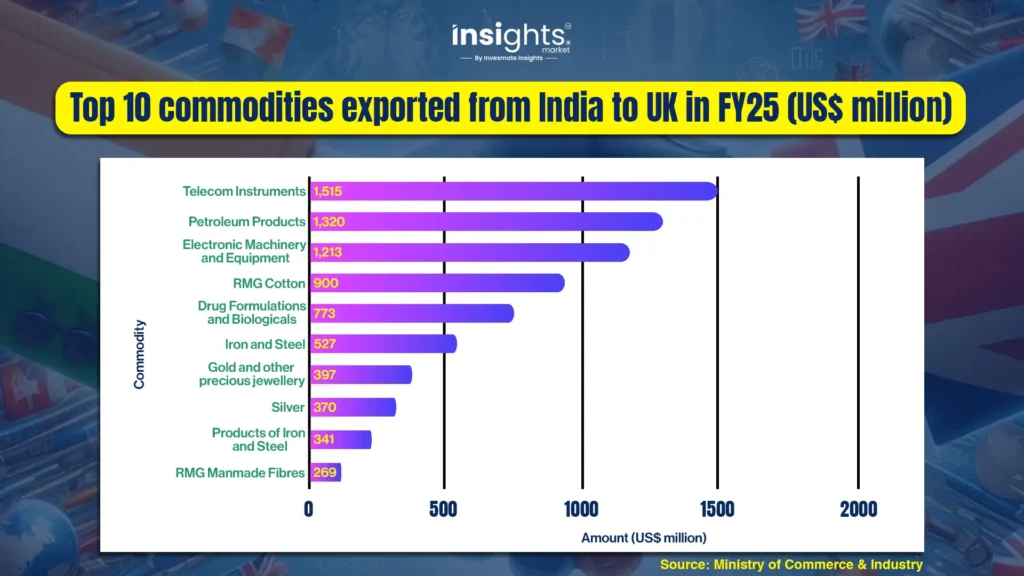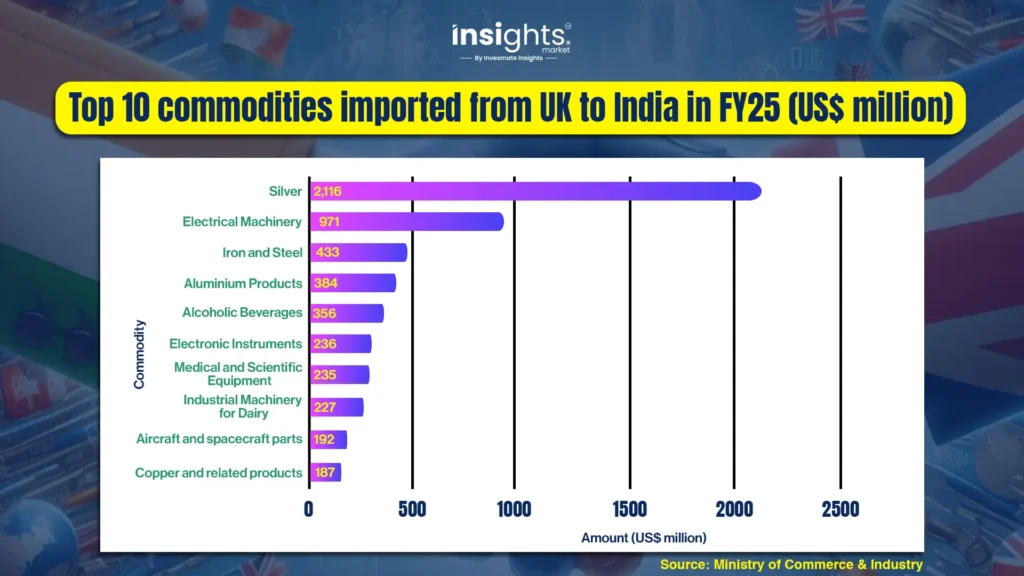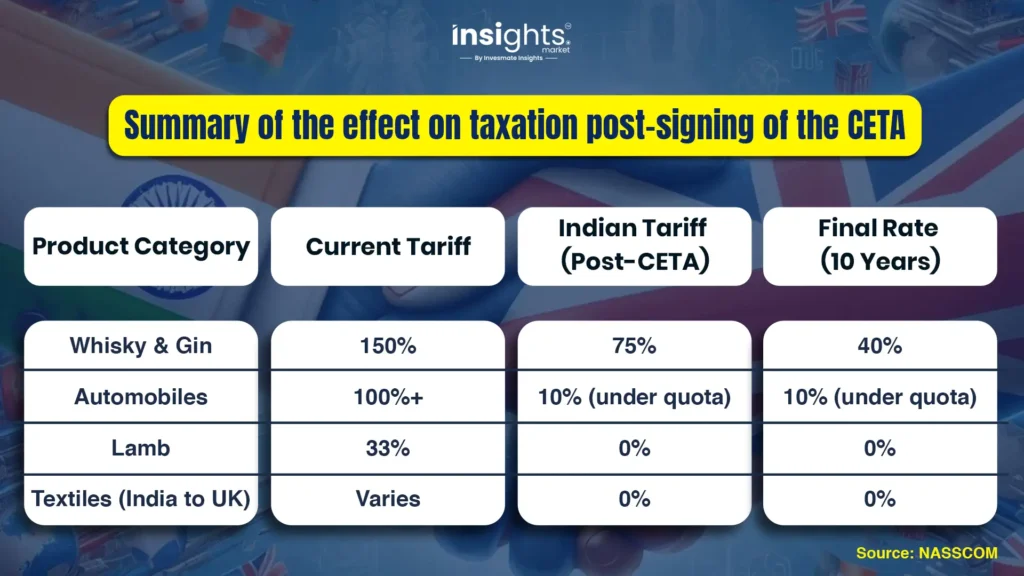![]()
Imagine you’re an Indian entrepreneur exporting garments to the UK. Overnight, the 12% duty your products faced is gone. Your profit margins just shot up. Thousands of businesses like yours—from textile makers in Tirupur to shrimp exporters in Andhra—are now set to win big.
That’s the real-world impact of the India–UK Comprehensive Economic and Trade Agreement (CETA), signed in July 2025—a landmark deal that goes far beyond trade.
CETA isn’t just about cutting tariffs—it’s about creating jobs, supercharging exports, opening new doors for skilled Indian professionals, and making MSMEs globally competitive.
Whether you’re an investor, exporter, policy-watcher, or just someone trying to make sense of how global trade shapes your wallet, this breakdown will show you why this deal truly matters for India’s future.
Let’s unpack what makes the India–UK CETA a potential game-changer for the economy—and for you.
Key Highlights: What India–UK CETA Brings to the Table
Tariff Elimination at Scale
- Nearly 99% of Indian exports to the UK now enjoy zero-duty access, making Indian goods more competitive across major sectors like textiles, gems, electronics, and chemicals.
In return, India opened 89.5% of its tariff lines, adopting a phased liberalization approach in sensitive sectors such as automobiles and dairy.

The significant tariff reductions achieved through the India–UK Free Trade Agreement, where duties on approximately 97.1% of tariff lines—covering key sectors such as processed foods, textiles, leather, electrical machinery, and gems & jewellery – have been reduced to 0%. This means Indian exports in these categories now enter the UK market duty-free, greatly improving their competitiveness and potential for growth.
Services Get a Major Boost
- Indian IT, business services, education, and healthcare gain deeper access into the UK market, with simplified visa rules and formal market access in 137 sub-sectors.
- Special visa quotas have been created for Indian chefs, yoga instructors, and artists, reflecting India’s soft power appeal.
No More Double Social Security Deductions
- The Double Contribution Convention allows Indian professionals on temporary UK assignments to avoid paying social security in both countries.
- This is expected to save over ₹4,000 crore for companies and benefit 75,000+ professionals over three years.
Simplified Rules for Exporters
- Self-certification of origin is now allowed, cutting red tape.
- Small shipments under £1,000 are exempt from complex documentation—especially helpful for MSMEs and e-commerce exporters.
Sector-Wise Deep Dive: Who Gains and How


These figures highlight the products that dominate bilateral trade, showcasing India’s strengths in telecom, petroleum, textiles, pharmaceuticals, and other sectors, while also reflecting the UK’s key exports to India. This data provides context for the areas poised for accelerated growth with tariff eliminations in place.
1. Textiles & Apparel
India’s textile exports just got a level playing field with competitors like Bangladesh and Cambodia.
- 12% UK import duty scrapped on yarn, fabric, and garments.
- Major production hubs—Tirupur, Surat, Ludhiana—stand to benefit.
- Stocks to Watch: KPR Mill, Gokaldas Exports, Arvind, Vardhman Textiles.
- With the UK importing $26.9B in textiles and India contributing just $1.79B, there’s massive headroom for growth.
2. Gems & Jewellery
- Tariffs of 4–10% abolished, improving India’s price competitiveness against Antwerp and Hong Kong.
- India’s exports to the UK—currently at $941M—are projected to double in 2–3 years.
- Stocks to Watch: Titan Company, Rajesh Exports, Vaibhav Global.
3. Leather & Footwear
- Zero duty across leather goods and footwear (previously up to 16%).
- India’s current UK exports: $440M, from a domestic market size of $5B.
- Room to double exports, targeting the UK’s $8.5B market.
- Beneficiary States: Uttar Pradesh, Tamil Nadu, West Bengal, Delhi NCR.
- Stocks to Watch: Mirza International, Bata India, Liberty Shoes.
P.S: Not a stock recommendation. Please do your own research before investing. 4. Agriculture, Food & Marine
- Zero tariffs on 1,437 agri and 985 food lines—from tea and spices to grapes and coffee.
- Marine exports, especially shrimp and fish, to surge with earlier duties (4.2–8.5%) removed.
- Coastal and agri states like Maharashtra, Kerala, Andhra Pradesh stand to gain.
5. Engineering, Electronics & Chemicals
- Zero-duty access for 1,659 engineering products and key electronics and chemical items.
- Engineering exports to UK—currently $4.28B—can double by 2030.
- Chemical exports, now ~$700M, could grow 30–40%.
- Boost for MSMEs in sectors like auto parts, renewables, and industrial machinery.
6. Pharma & Medical Devices
- Zero duties on generic pharmaceuticals.
- Framework for mutual recognition of Indian certifications, enabling smoother entry into the UK’s $30B pharma and $32B med-tech markets.
7. Services & Talent Mobility
- Indian professionals across IT, finance, law, healthcare, and education can now access the UK market more easily.
- Mutual recognition agreements (MRAs) for nursing, accountancy, and architecture are expected within 12 months.
- Business visitors and professionals allowed up to 3-year stays, no quotas or economic needs test (except in a few professions).
Read Also: How To Build A Stock Market Portfolio? Learn These 9 Essential Steps
Strategic and Macro Wins for India
Export-Led Job Creation
Labor-intensive sectors like textiles, leather, and food processing will see higher output, more employment, and wage growth, especially for MSMEs and women entrepreneurs.
Valuation Boost for Export-Focused Stocks
Export-heavy firms gain stronger earnings visibility and higher market confidence, triggering a likely re-rating of listed stocks.
Forex and Rupee Stability
Higher export volumes mean stronger foreign exchange inflows, supporting the rupee and current account balance.
Digital, Start-Up & Investment Access
CETA provisions also enable easier cross-border digital services, start-up scaling, and FDI flows into emerging sectors.
Balanced Growth, Not Blind Openness
India retains key protections for sensitive sectors like automobiles, dairy, cereals, gold, and smartphones, aligning with Make in India and Atmanirbhar Bharat.
Risks and Realism: What to Watch Out For
- Implementation Gaps: Bureaucratic delays, UK economic slowdown, or protectionist shifts could dampen short-term benefits.
- Safeguard Mechanisms in Place: The agreement includes bilateral clauses to handle sudden import surges or unfair trade practices.

Final Thoughts: More Than Just a Trade Deal
The India–UK CETA is not just about tariff lines and customs paperwork—it’s a strategic bet on India’s growing global clout. It unlocks new markets, new jobs, and new investments, while also reinforcing India’s export resilience in a geopolitically shifting world.
For businesses, MSMEs, investors, and skilled professionals, this is a moment to pivot—to scale globally, grow faster, and be part of India’s next big growth story.
Now is the time to ask: Is your business export-ready? Because India certainly is.
FAQs
It’s a trade deal signed in July 2025 that removes or reduces tariffs on 99% of goods between India and the UK—boosting exports, jobs, and competitiveness.
Textiles, leather, gems & jewellery, processed foods, engineering goods, electronics, chemicals, pharma, and marine products gain the most due to zero or lower tariffs.
The FTA opens up export markets for MSMEs, creating more jobs and boosting wages—especially in labor-intensive sectors like textiles and food processing.
India exports garments, telecom gear, jewellery, and pharma. The UK exports silver, machinery, steel, aluminium, and alcoholic beverages to India.
Tariffs on ~97% of traded goods are now zero—making Indian products far more competitive in the UK.
Indian professionals in the UK are exempt from UK social security payments for up to 36 months, saving companies and workers significant costs.




